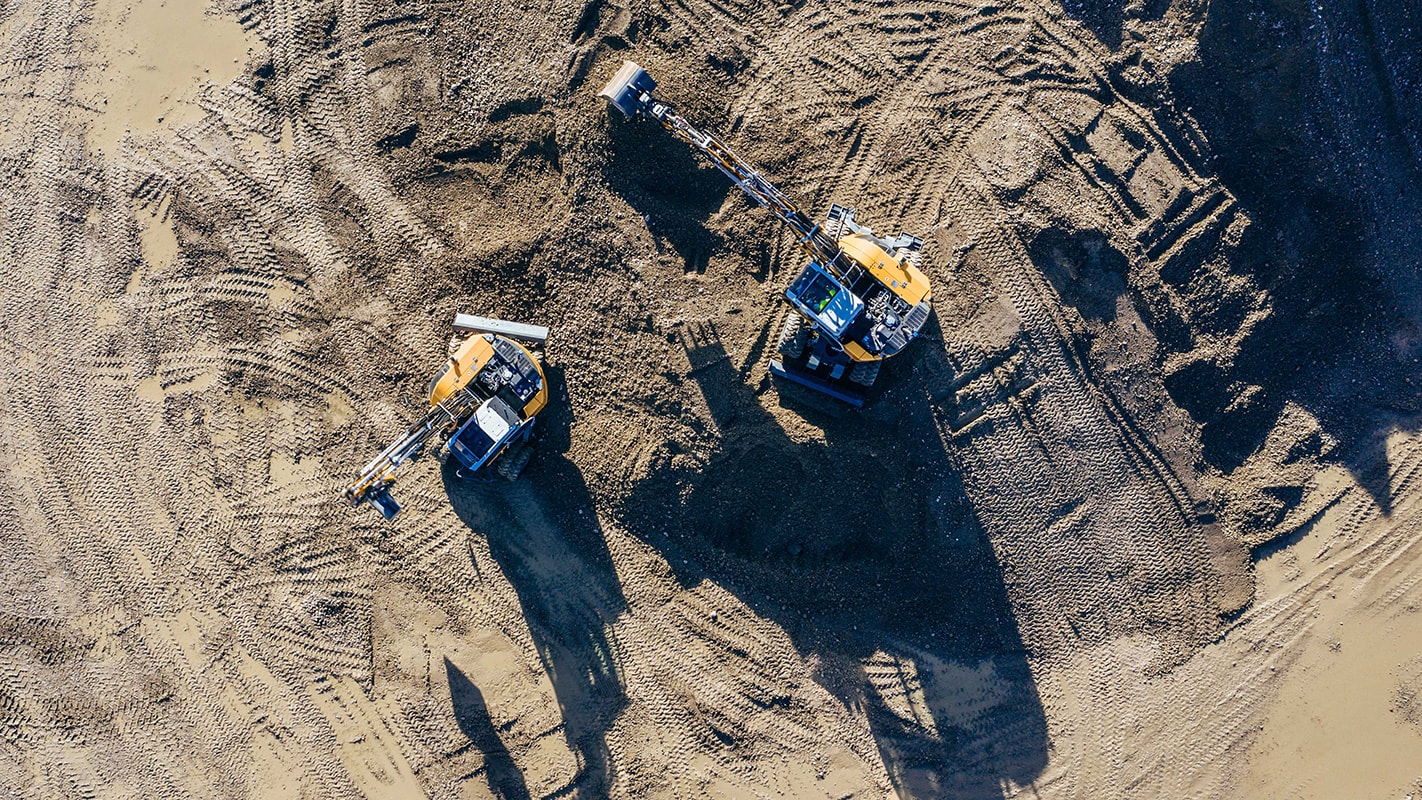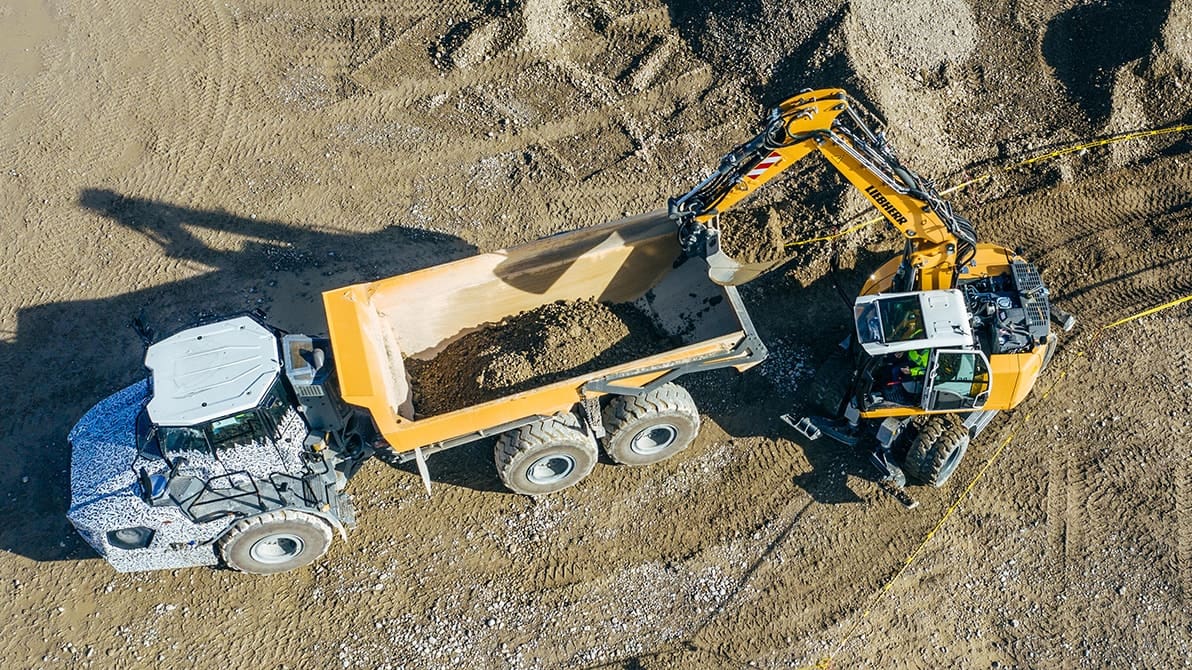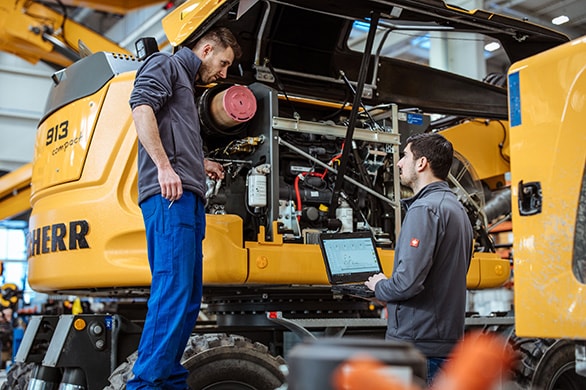You are here
Liebherr Group: Products & Services for Republic of Korea
Other websites for Republic of Korea

Complex data calculations, digital simulations and hundreds of hours driving and digging on challenging test sites all add up to one thing: in Kirchdorf an der Iller, Liebherr is working hard to perfect its next generation of earthmoving and material handling machines.

The shovel cuts deep into the gravel. The A 913 Compact Litronic is able to turn in a remarkably tight space in order to load the enormous articulated dump truck that is waiting. Manuel Wirthensohn is at the controls of the wheeled excavator. His interest in the actual freight is secondary – what he’s really fascinated by is the machine itself and how the new hydraulic excavator manoeuvres and balances loads.
Wirthensohn is a test engineer. As Head of Testing and Validation for the product line hydraulic excavators, he is responsible for earthmoving machines from 10 to 24 tonnes. He and his team have been working for weeks to test every aspect of the A 913 Compact Litronic, a new, extremely compact hydraulic excavator, in realistic conditions, deploying a wide range of measurement technology. “Anything that isn’t perfect is immediately improved – while testing continues,” explains Wirthensohn with a wink.
Time is limited. Batch production is due to start. It won’t be long before the A 913 Compact will be proving its qualities on city-centre construction sites – and there’s no room for teething troubles. Manuel Wirthensohn and his team are using the new development and demonstration centre in Kirchdorf an der Iller to ensure their machine is perfectly tuned. The facility, owned by Liebherr-Hydraulikbagger GmbH, is unique in Europe. Development, design and test engineers all work closely together, pooling their various skills in a single location.

On a total area of 12.8 hectares, there is a test hall with an administration building and a large test site with a 1.2 km test track in this development and demonstration centre, which is unique in Europe.

We are in hall 18 at the development and demonstration centre. At first glance, it seems to be an enormous workshop, but as we get closer, it turns out to be a vast research laboratory. The engineers here rely on their torque wrenches and screwdrivers just as much as their measurement technology, laptop connections and digital analysis tools. “We measure the entire machine and all its attachments, in order to obtain as much knowledge as possible directly in the field,” Manuel Wirthensohn tells us.
The A 913 Compact has more than 60 measurement points, which the engineers use to model the hydraulic pressure system and the range of movement on the prototypes during deployments. “It takes two days to configure the machine. The actual tests then take months. We implement the improvements while testing continues, and take them into account for the tests,” explains Wirthensohn. “As well as the data, we record the experiences of the drivers carrying out the field tests on the test site.”
Comprehensive long-term tests are also carried out on the testing stands. The focus is on testing and optimising the hydraulic systems, subsystems and load-bearing structural components, such as the undercarriage and chassis. Just now, the bright lights flooding the hall are illuminating a hardness test on the swivel arm of a wheeled excavator. “What we mean by that is movement and loads without considering losses,” explains Wirthensohn. “We run 4.5 million load cycles in continuous non-stop operation over several weeks – there’s absolutely no let-up for the mechanics.” The goal of these laborious procedures is to test the structural mechanics of the steel construction so it can be further optimised.

“Could you come over? We’re about to start the motor, and then work on the site will begin.” When Manuel Wirthensohn phoned Mathias Graf a few weeks ago, Mathias set off straight away. The development engineer didn’t have far to go from his office to Hall 18, where everything was in place to launch the first field tests of the A 913 Compact. “It was a fantastic moment,” recalls Graf. “As the development engineer, it’s great to participate at these times.”
After all, he and his colleagues from the development-engineering department have followed the machine’s progress from the first sketches on a sheet of paper through to a completed product – and on to testing with the customer.
The systematic development process partly involves classical engineering, beginning with a drawing and the creation of a parts list. “The A 913 Compact came from our modular platform, where we link new features to tried-and-tested technology,” explains Mathias Graf.
The daily development work involves regular coordination sessions with other departments. These often dig right down into details, calculating manufacturing costs or the welding characteristics of a particular assembly. “We are responsible for ensuring that all the steps in the development process fit together and we end up with a coherent product for batch production,” states Graf.


Developing a product like the A 913 Compact takes around 36 months. In order to keep development times short and still produce the best results, the design engineers have recently started using virtual reality. “We can carry out tests of the field of vision at the virtual prototype stage for example,” says Graf. These ensure that there is sufficient visibility in all directions under any driving or working conditions. The virtual reality systems can also be used to test the accessibility of service and maintenance points in advance.
Mathias Graf details the advantages of the new technology: “We can use the 3D simulations to test components and assemblies that don’t actually exist yet. That means that we can eliminate errors before we even start to build the prototypes.” The overarching goal is to make the functionality and quality of the prototype machines as high as possible, right from the very first machine. This ensures a relatively short process from the prototype to the batch production of an optimised wheeled excavator.

The future is digital – and increasingly so in design engineering. Virtual engineering means supporting and steering development processes with the assistance of 3D digital models. Special data goggles, 3D visualisations and virtual reality are used to model the experience of a real-time interactive virtual environment, where either products or manufacturing processes can be simulated.
Still, however closely the digital solutions are able to model or create reality, driving real excavators on the testing site remains an essential part of the process. “The feel of a wheeled excavator and its power as it works is – and always will be – something quite unique,” explains Graf. The new development and demonstration centre combines the best of both worlds, virtual and real.